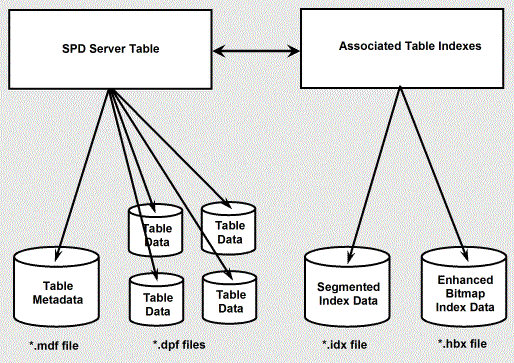Organizing SAS Data
SPD Server Tables
SPD Server software
alters SAS tables to enable high-performance processing. SPD Server
tables are physically different from a Base SAS table. You can use
tables in either SAS or native SPD Server format. For more information
about how to migrate tables between SAS and SPD Server, see Migrating Tables between SAS and SPD Server.
SAS tables store a single
file that contains the data descriptors and the table data. The data
are column values. The descriptors are metadata that describe the
column and data formatting that the table uses.
SPD Server tables do
not reuse space. When an SQL command to delete one or more rows from
a table is issued, the row is marked deleted and the space is not
reused. You must copy the table in order to recapture the space.
SPD Server Component Files shows
differences in the architecture between SPD Server tables and SAS
tables. SPD Server uses component files to store tables. One component
file stores the stream of data values. Another component file stores
the column and data descriptors. If you create an index for a column
or a composite of columns, SPD Server creates component files for
each index.
SPD Server Component Files
SPD Server Component Files
shows the components of SPD Server tables.
SPD Server partitions
component files when they are created to prevent the files from growing
too large. SPD Server stores each partitioned component file as one
or more disk files. The partitioning provides the following advantages:
-
Access via multiple directory paths: SPD Server can access data libraries that span numerous directory paths and storage devices. SPD Server software partitions massive data libraries into component files. The component architecture enables rapid, threaded data access, and circumvents device capacity and file size limitation issues. Storage lists transparently track component file locations, so users can access multiple storage devices as a single volume, even if file partitions exist in different locations.
-
Flexibility in storage: You do not need to store data tables and associated indexes in the same location when you use SPD Server component files. You can store data files and associated indexes in different directory structures or on different devices. When you are deciding where to store component SPD Server tables, you need to consider only the cost, performance, and availability of disk space.
SPD Server Table Indexes
SPD Server enables you
to create indexes on table columns. SPD Server can thread WHERE clause
evaluations for tables that are not indexed. Indexes enable rapid
WHERE clause evaluations. You should index large tables to optimize
SPD Server performance. For more information about SPD Server indexes,
see Indexing Tables.
Copyright © SAS Institute Inc. All rights reserved.
